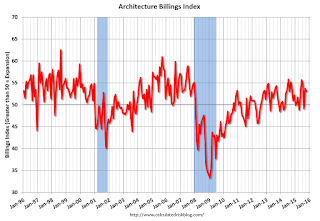From the AIA: Architecture Billings Index on Solid Footing
There has been increasing levels of demand for design services for nearly all construction project types for the majority of the year as revealed in the Architecture Billings Index (ABI). As a leading economic indicator of construction activity, the ABI reflects the approximate nine to twelve month lead time between architecture billings and construction spending. The American Institute of Architects (AIA) reported the October ABI score was 53.1, down slightly from the mark of 53.7 in the previous month. This score still reflects an increase in design services (any score above 50 indicates an increase in billings). The new projects inquiry index was 58.5, down from a reading of 61.0 the previous month.
“Allowing for the possibility of occasional and minor backsliding, we expect healthy business conditions for the design and construction industry to persist moving into next year,” said AIA Chief Economist Kermit Baker, Hon. AIA, PhD. “One area of note is that the multi-family project sector has come around the last two months after trending down for the better part of the year.”
...
• Regional averages: South (56.2), West (54.4), Midwest (52.6), Northeast (49.2)
• Sector index breakdown: commercial / industrial (55.1), mixed practice (54.9), multi-family residential (52.5), institutional (51.4)
emphasis added
 Click on graph for larger image.
Click on graph for larger image.This graph shows the Architecture Billings Index since 1996. The index was at 53.1 in October, down from 53.7 in September. Anything above 50 indicates expansion in demand for architects' services.
Note: This includes commercial and industrial facilities like hotels and office buildings, multi-family residential, as well as schools, hospitals and other institutions.
The multi-family residential market was negative for most of the year - suggesting a slowdown or less growth for apartments - but has now turned positive.
According to the AIA, there is an "approximate nine to twelve month lag time between architecture billings and construction spending" on non-residential construction. This index was positive in 9 of the last 12 months, suggesting a further increase in CRE investment over the next 12 months.
No comments:
Post a Comment
Note: Only a member of this blog may post a comment.